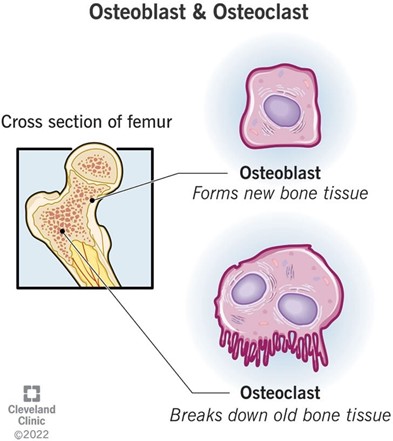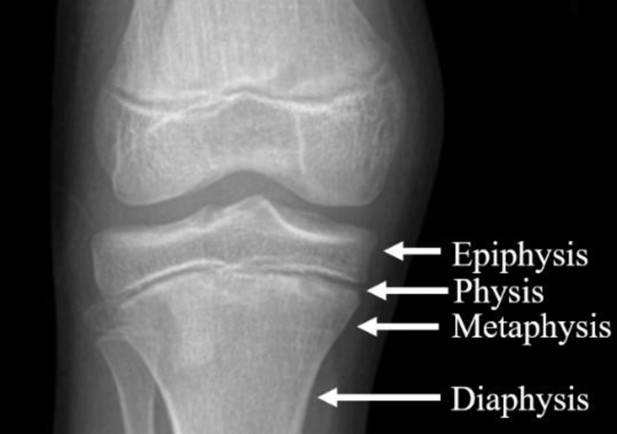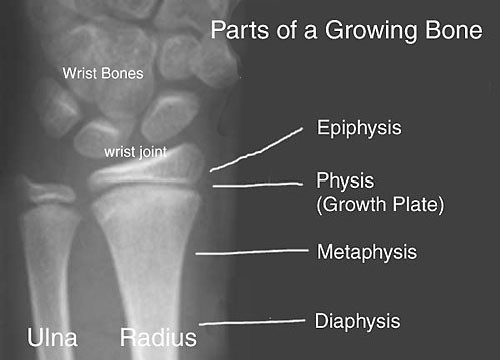Which type of cell is responsible for breaking down bone tissue?
Osteoclast.
Chondrocytes.
Osteocytes.
Osteoblast.
The Correct Answer is A
Osteoclasts are the type of cells that break down bone tissue by secreting acid and enzymes.
They are derived from monocytes and macrophages, two types of white blood cells.

Choice B is incorrect because chondrocytes are the cells that produce and maintain cartilage, a flexible connective tissue found in joints.
Choice C is incorrect because osteocytes are the mature bone cells that maintain the mineral concentration of the bone matrix.
They are derived from osteoblasts, the bone-forming cells.
Choice D is incorrect because osteoblasts are the cells that form new bone by synthesizing and secreting collagen and calcium salts.
They are derived from osteogenic cells, the undifferentiated cells that can divide.
Nursing Test Bank
Naxlex Comprehensive Predictor Exams
Related Questions
Correct Answer is ["epiphyseal analysis"]
Explanation

The epiphysis is the rounded end of the femur that articulates with the hip bone and knee joint.
As a child grows, the epiphysis gradually fuses with the rest of the bone through a process called ossification.
By examining the degree of fusion of the epiphysis with the femur on an X-ray, doctors can estimate the age of the child.

In general, the younger the child, the less fused the epiphysis will be, and the easier it will be to determine the child's age.
However, it's important to note that this method provides only an approximate age range and cannot be used to determine an exact age.
Correct Answer is ["External rotation of the shoulder joint"]
Explanation
External shoulder rotation is the movement of the humerus bone away from the centerline of the body, rotating the arm so that the palm faces away from the body.
This movement is achieved by the contraction of the external rotator muscles of the shoulder, which include the infraspinatus, teres minor, and posterior fibers of the deltoid muscle.
The joint involved in external shoulder rotation is the glenohumeral joint, also known as the shoulder joint.
The shoulder joint is a ball-and-socket joint formed by the articulation between the head of the humerus bone and the glenoid cavity of the scapula bone.
This joint allows for a range of movements, including:
1. Internal shoulder rotation: This is the opposite movement of external rotation, in which the humerus bone rotates inward toward the centerline of the body, with the palm facing inward.
2. Shoulder flexion: This is the movement of the humerus bone forward and upward, bringing the arm closer to the body's front.
3. Shoulder extension: This is the movement of the humerus bone backward and downward, moving the arm away from the body's front.
4. Shoulder abduction: This is the movement of the humerus bone away from the body's midline, raising the arm out to the side.
5. Shoulder adduction: This is the movement of the humerus bone toward the body's midline, bringing the arm back down to the side of the body.
6. Shoulder horizontal abduction: This is the movement of the humerus bone away from the body's midline at shoulder height.
7. Shoulder horizontal adduction: This is the movement of the humerus bone toward the body's midline at shoulder height.
All of these movements of the glenohumeral joint are important for many daily activities, including reaching, throwing, pushing, pulling, and lifting.
Whether you are a student looking to ace your exams or a practicing nurse seeking to enhance your expertise , our nursing education contents will empower you with the confidence and competence to make a difference in the lives of patients and become a respected leader in the healthcare field.
Visit Naxlex, invest in your future and unlock endless possibilities with our unparalleled nursing education contents today
Report Wrong Answer on the Current Question
Do you disagree with the answer? If yes, what is your expected answer? Explain.
Kindly be descriptive with the issue you are facing.
